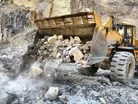Iron ore makes comeback, but is it here to stay?

Australian miners recently rejoiced as the price of iron ore increased nearly 10 per cent.
As was written in our sister site Mining Global, the nation’s top commodity bounced back after a 10 per cent drop just one day earlier, making it the largest single-day fall and rise ever in a 48-hour period. It also ended a 10-day slump as sale of Chinese equities came to a halt while the price of most industrial metals went up.
Mining giant BHP Billiton went up nearly three per cent, while its competition Rio Tinto saw a 2.32 per cent increase and Fortescue Metals rose 1.68 per cent.
This is expected to have a big impact on revenue for both Australia and China, as Australia is the world’s largest supplier of iron ore—which is key to making steel—while China is the Aussie’s top customer. The dropping price of iron ore was severely impacting government revenue as the nation’s most important export.
RELATED TOPIC: Can Atlas' operations at Mount Webber help iron ore market rebound?
As a result, China paused its trading in over half of the nation’s listed stocks and requested assistance from its major stockbrokers through a large stabilization fund in order to help calm the market. Stocks in Shanghai rose 5.8 per cent—the most since 2009.
This comes after BHP and Rio each had a low-cost output in 2014 that created a large supply of iron ore, while growth in China slowed down considerably.
RELATED TOPIC: BHP Billiton cuts back in effort to become lowest-cost iron ore producer
Increased supply in recent months along with a decrease in Chinese demand has had iron ore on a steady decline. Even with the latest 10 per cent spike, the majority of smaller Aussie miners will still be producing at a loss, forcing many cut costs.
However, Rio Tinto believes the long-term market for iron ore is stable and will continue to produce a high amount of revenue in Australia. After providing its second-quarter operations review, Rio noted iron ore production and shipment increased compared to 2014 despite unseasonal, severe weather in Western Australia that included two tropical cyclones that lost about seven million tonnes.
RELATED TOPIC: Iron Ore Hovers Close to $US50, Hits Six-Year Low
Rio had a record-high first-half of production and sales, as it brought in 146 million tonnes and 146.5 million tonnes respectively from its site in Pilbara. The company also expects to increase its production capacity to 340 million tonnes as it finishes up important pieces of its infrastructure that will support future expansion.
However, some of the top mining companies may have to shut down in order for the market to truly stabilise, as the reality of China’s decreased steel production sets in.
Check out the latest edition of Business Review Australia!
- Executive shakeup at L’Oreal China amid growing complexitiesLeadership & Strategy
- How Longi became the world’s leading solar tech manufacturerSustainability
- How software giant Atlassian became a climate action leaderTechnology
- Why Australia must embrace digital reporting – or lag behindSustainability
Featured Articles
Nirvik Singh, Global COO and President International of Grey Group, cultivating culture and utilising AI to enhance rather than replace human creativity
On a mission to accelerate the adoption of sustainable energy solutions, US$30 billion Chinese tech firm Longi is not just selling solar – but using it
Armed with an ambitious billion-dollar strategy, Samsung is on track to achieve net zero carbon emissions company-wide by 2050 – but challenges persist



